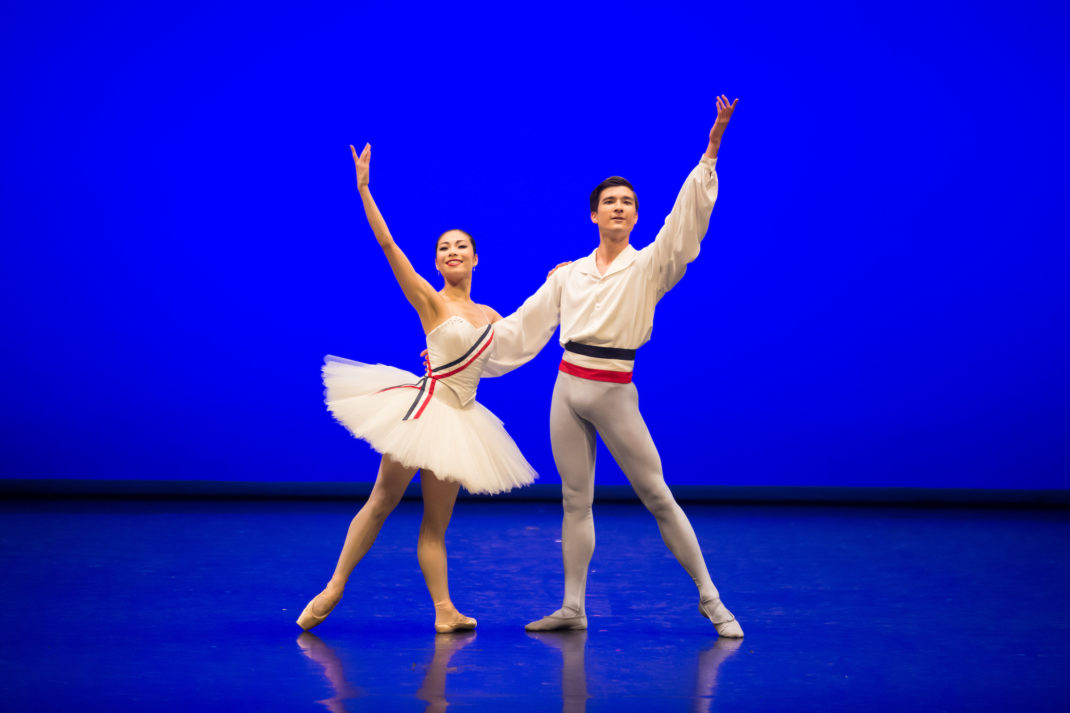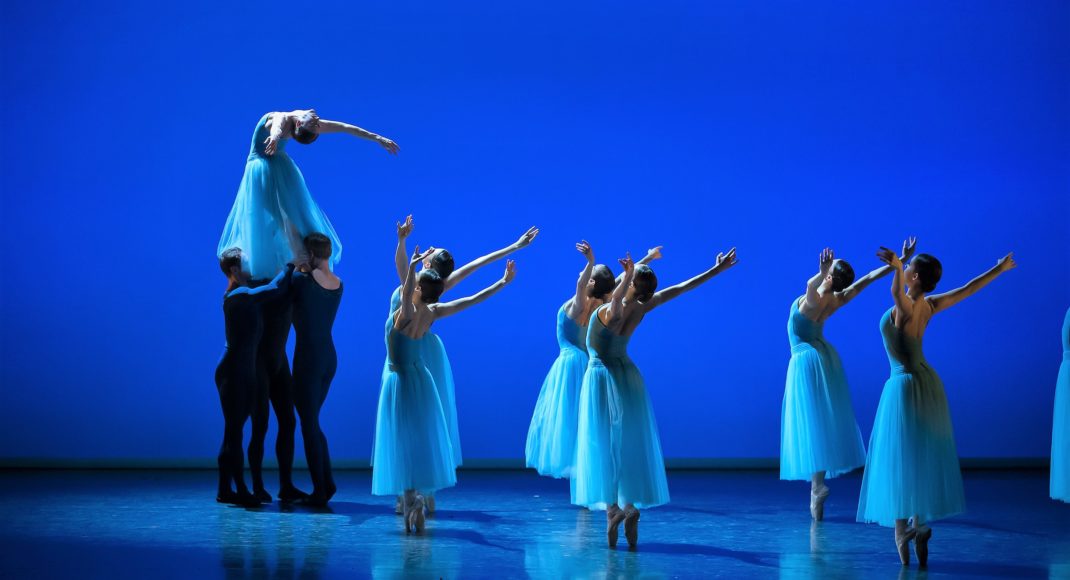16 August 2019, Opera House, Wellington
reviewed by Jennifer Shennan
Bold Moves is a ‘something for everyone’ mixed bill of four works that include old, older, new and not so new, with the dancers proving more than equal to the demands of stylistic versatility for each of the contrasting choreographies. The program requires a majority of female dancers across all the pieces, and among them are three standout performers.
Serenade (to Tchaikovsky, Serenade for Strings), was choreographed 85 years ago by George Balanchine for students at his company’s ballet school. Among the prolific choreographer’s scores of works, it sits lyrically apart, an abstract style of classical movement with tweaks here and whimsy there, as he built little mistakes made in rehearsal into the choreography, reflecting his sense of fun when working with young dancers. The work was first staged here by Una Kai, renowned former dancer with New York City Ballet, and our company’s artistic director in 1970s. Harry Haythorne, subsequent director, staged it on New Zealand School of Dance in 1980s and found there the perfect setting for it with a student cast.
This line-up of 17 females in ‘moonlight blue’ danced the long first section with line and ensemble aspects finely wrought, but I missed the lightness of subtleties remembered (and a number of dancers from those earlier productions who were in the audience later agreed). Some performers had ethereal and distant facial expressions, while others grinned cheerfully at the audience—somewhat distracting since it’s not just the movement we are watching, but also the dancers’ thoughts we are following. What are they thinking? The second section with fewer dancers has a range of sculptured arm shapes and attractive groupings that are satisfying to follow. The woman beside me swooned and gasped with pleasure throughout as she sipped her wine. It’s always good to witness people enjoying themselves, but to my taste this was an oaked chardonnay.

The pas de deux that followed, Russian style from 1932 but fashioned as though much earlier, Flames of Paris, is a sizzler for ballet competitions and the virtuoso display of gala nights, so no great poetry here. Wrong. It’s all in the how, not the what—and the quality of dancing by Mayu Tanigaito is a revelation, as always. Her technique is so fabulously assured she can afford to toss it to one side and simply offer us her pure pleasure at delivering a clean line, an effortless turn, a nonchalant pose, all effort masked, a laughing toss of the head, a loving smile, a way to live. She is the company’s longstanding leading dancer in all these respects. Her partner was Laurynas Vejalis, also a dancer of great technical ability, but he did not seem to be offering that as a gift to her, so she instead offered hers to us. Lucky us. This was top-shelf champagne.
Stand to Reason, by South African choreographer, Andrea Schermoly, commissioned by RNZB in 2018, marks 125 years since the beginnings of universal suffrage. Danced by eight women who gave it a wonderfully strong and motivated reading, it encourages everyone to believe in democracy in a wider society, and in all the institutions within it. There are numerous back projections of text from suffragettes’ writings, which were not legible however from many areas of the auditorium, and it could seem wise to reduce this distraction since the text is already reproduced in the printed program, and its message built in to the choreography. Kirby Selchow and Madeleine Graham were truly standout performers among the totally focused cast. Brandy for courage, methinks.

William Forsythe’s Artifact II, 1984, perhaps with Orwell in mind, was brought here by his Ballett Frankfurt to an International Arts Festival season in 1994. It employs his hallmark extremism of anatomy +, with over-extensions of limbs creating shapes and thrusts that soon amount to shouting rather than speaking. (‘It’s hard to lip-read a shouting man’—Leonardo da Vinci warned us in the 15th century, and that is still the case). Two couples embark on simultaneous pas de deux, which is like four people speaking at once, impossible to watch or ‘hear’ them all. My eye gratefully went to Mayu Tanigaito and Massimo Margaria who danced with a totally immersed care and attention to each other, making quite the quality highlight of the piece. I know there exist interviews galore with Forsythe that explain the aesthetic and the choreographic intention of this work, but the reality is what comes to us across the footlights.
The Bach Chaconne used here means what we hear is the opposite of what we see. A chaconne is a baroque dance & music form that moves ever forward over a ground bass, without the theme & variations/verse & chorus structure of other baroque dances, and thus represents a through-composed journey. Douglas Lilburn caught well the notion of journeying in his solo piano composition by that title (worth choreographing some time?), but Bach’s chaconne is so wedded now to the talisman choreography by Jose Limon (given stellar performances by Baryshnikov in this same venue back in 1990s) with the solo musician alongside him on the stage. The dance, staged by Louis Solino, was also a number of times nobly performed here by Paul Jenden with Richard Mapp playing the Busoni piano transcription. Those achingly beautiful memories create a challenge to reconcile the use of the same music with a ballet like Artifact.
The curtain is rung down numerous times while the work continues onstage (except in this production we had the impression the dancing stopped then started again each time the curtain rose). It has a point the first time, perhaps, but the numerous repeats of the curtain crashing down become increasingly tiresome. I still find this as cynical and fragmented a work as I did on earlier viewing, and one cannot help but wonder what price the dancers pay for such extreme physical demands made on them in its delivery. We have seen Forsythe’s In the Middle Somewhat Elevated in several seasons by RNZB, also an extreme work, though the aesthetic there draws on its thunderbolt percussive accompaniment. Excitement always won the day when our former company dancers performed that work (most memorably Abigail Boyle, Kohei Iwamotu, Laura Saxon Jones, Jacob Chown) who made it strikingly their own. Artifact though is a cocktail of different ingredients.
For years our company has had an equal weighting of female and male dancers, without a star ranking system but with recognition of the strengths in individual dancers—as classicists and actors, with character or humour—and with seasons extended over ten days to offer opportunities for us to savour alternate casts in lead roles. There was also a number of stellar visiting ballet masters, among the world’s best, who brought refreshing stimulation to the dancers. The company now has a new line-up and a new look—a system of star ranking introduced, seasons reduced to only a few days, no visiting ballet masters, an increased number of dancers, many more females than males, with a number of young performers and apprentices it is too soon to identify individually, some trained locally but still including many more imported to swell the ranks. That recruiting is difficult to accept, given how many fine young dancers are in training throughout this country, and how many other New Zealand dancers continue to search for work abroad. (Wouldn’t a young dancer/graduate ensemble here offer them and the country something to fill that gap?) And the company without Sir Jon Trimmer retained to assist in the styling and staging of works, and as a quietly masterful mentor to younger dancers, is not the one we have known for decades, and a decision that remains indeed difficult to fathom.
Ballet companies, like families, grow from their whakapapa. Every generation is itself, has parents and grandparents, children and grandchildren. Our company’s early repertoire includes classics of New Zealand vintage that could well be re-staged, (consider if you will—Tell me a Tale, Ragtime Dance Company, A Servant of Two Masters, Bliss, No Exit, Dark Waves, The Decay of Lying, rose and fell, halo, Napoli. Broadcast News, Sweet Sorrow, Mantodea, Charade, Prismatic Variations… none of which is older than Serenade) and many of our choreographers and ballet masters with the required experience are free-lancing here and abroad. If we don’t stage these works, no-one will. Kia mau te wehi, kia kaha. Ka tu ka ora, ka noho ka mate. Mauri, mauri, kam na mauri. Tekeraoi. (Bold Moves. Take courage. Standing up, all is well, lying down, all is not well. Spirit, courage, blessings).
Jennifer Shennan, 19 August 2019
Featured image: Dancers of Royal New Zealand Ballet in George Balanchine’s Serenade, 2019. Photo: © Stephen A’Court


Fabulous review Jenny, could not have said it better.
Former RNZB dancer from 1970’s. Contrary to the new brooms beliefs we are an educated bunch and we are now being fed a regurgitated diet instead of the standard we are use to.